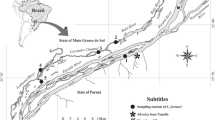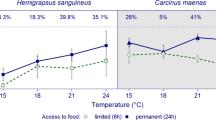Summary
In the northern Gulf of California the adult distribution of the intertidal barnacle species, Chthamalus anisopoma, on exposed shores is approximately between 0.0 and 2.0 m above mean low water (MLW). The species is typically absent in protected (from wave splash) areas. In this study, I examined a series of alternative hypotheses relating to the factors that could be responsible for limiting the distribution. Post-settlement factors appear to be unimportant because settlement was largely restricted to areas within the adult distribution. Two processes could account for the high correlation between settlement and adult distributions. First, hydrodynamic factors could restrict deposition of larvae to sites that coincidently were in areas in which individuals could survive to maturity. Second, larvae may choose to settle only on sites where they can survive to maturity. Of the two, the later was supported as settlement could be induced on surfaces outside the adult distribution using transplanted adult conspecifics as cues. Thus, competent larvae were present outside the adult distribution of Chthamalus zone but did not settle under normal conditions. Also, there was no evidence that pre-emption of space by other sessile species, by itself, restricted the distribution of Chthamalus. Settlement within the existing adult distribution may be an evolutionary response to increased mortality for individuals settling outside the adult distribution compared to those settling within it.
Similar content being viewed by others
References
Brusca RC (1980) Common intertidal invertebrates of the Gulf of California. The University of Arizona Press, Tucson, Arizona, USA
Butman CA (1987) Larval settlement of soft-sedment invertebrates: the spatial scales of pattern explained by active habitat choicee and the emerging role of hydrodynamical processes. Oceanogr Mar Bio Ann Rev 25:113–165
Caffey HM (1985) Spatial and temporal variation in settlement and recruitment of intertidal barnacles. Ecol Monogr 55:313–332
Carr MH (1989) Effects of macroalgal assemblages on the recruitment of temperate zone fishes. J Exp Mar Biol Ecol 126:59–76
Connell JH (1961 a) Effects of competition, predation by Thais lapillus, and other factors on natural populations of the barnacle Balanus balanoides. Ecol Monogr 31:61–104
Connell JH (1961 b) The influence of interspecific competition and other factors on the distribution of the bamacle, Chthamalus stellatus. Ecology 42:710–723
Connell JH (1970) A predator-prey system in the marine intertidal region. I Balanus glandula and several species of Thais. Ecol Monogr 740:49–78
Connell JH (1985) The consequences of variation in initial settlement vs. post-settlement mortality in rocky intertidal communities. J Exp Mar Biol Ecol 93:11–45
Crisp DJ (1974) Factors influencing the settlement of marine invertebrate larvae. In: Grant PT Mackie AM Chemoreception in marine organisms, Academic Press, London, pp 177–265
Crisp DJ, Meadows PS (1963) Absorbed layers: the stimulus to settlement in barnacles. Proc R Soc London Biological Sci 158:364–387
Day RE, Quinn GP (1990) Comparisons of treatments after an analysis of variance in ecology. Ecol Monogr 59:433–463
Denley EJ, Underwood AJ (1979) Experiments on factors influencing settlement, survival, and growth of two species of barnacles in New South Wales. J Exp Mar Biol Ecol 36:269–293
Denny MW (1988) Biology and the mechanics of the wave-swept environment. Princeton University Press, Princeton NJ, USA
De Wolf P (1973) Ecological observations on the mechanisms of dispersal of barnacle larvae during planktonic life and settling. Neth J Sea Res 6:1–129
Doherty PJ, Williams D (1988) The replenishment of coral reef fish populations. Oceanogr Mar Biol Annu Rev 26:487–551
Dungan ML (1985) Competition, and the morphology, ecology, and evolution of acorn barnacles: an experimental test. Paleobiology 11:165–173
Gaines S, Roughgarden J (1985) Larval settlement rate: a leading determinant of structure in an ecological community of the marine intertidal zone. Proc Nat Acad Sci 82:3707–3711
Gaines S, Brown S, Roughgarden J (1985) Spatial variation in larval concentrations as a cause of spatial variation in settlement for the barnacle Balanus glandula. Oecologia 67:267–272
Geraci S, Romairone V (1982) Barnacle larvae and thein settlement in Genoa harbour (North Tyrrhenian Sea). Mar Ecol 3:225–232
Grosberg RK (1982) Intertidal zonation of barnacles: the influence of planktonic zonation of larvae on vertical distribution of adults. Ecology 3:894–899
Hatton H (1938) Essals de bionomie explicative sur quelques especes intercotidales d'algues et d'animaux. Ann Inst Oceanogr Monaco 17:241–348
Hawkins SJ, Hartnoll RG (1982) Settlement patterns of Semibalanus balanoides (L.) in the Isle of Man (1977–1981). J Exp Mar Biol Ecol 62:271–283
Howe HF, Southwood J (1982) Ecology of seed dispersal. Ann Rev Ecol Syst 13:201–228
Jensen RA, Morse DE (1984) Intraspecific facilitation of larval recruitment: gregarious settlement of the polychaete Phragmatopoma californica (Fewkes). J Exp Mar Biol Ecol 83:107–126
KeoughMJ (1988) Benthic populations: is recruitment limiting or just fashionable? Proc. 6th Inter. Coral Reef Cong., August 8–12, 1988, Townsville, Australia. 1:141–148
Keough MJ, Chernoff H (1987) Dispersal and population variation in the bryzoan Bugula neritina. Ecology 68:199–210
Keough MJ, Downes BJ (1982) Recruitment of marine invertebrates: the role of active larval choices and early mortality. Oecologia 54:348–352
Knight-Jones EW (1953) Laboratory experiments on gregariousness during settling in Balanus balanoides and other barnacles. J Exp Biol 30:584–598
Knight-Jones EW, Stevenson JP (1950) Gregariousness during settlement in the barnacle Elminius modestus (Darwin). J Mar Biol Ass UK 29:281–297
Larmon VN, Gabbott PA (1975) Settlement of cyprid larvae of Balanus balanoides and Elminius modestus induced by extracts of adult barnacles and other marine animals. J Mar Biol Ass UK 55:183–190
Levinton JS (1982) Marine Ecology. Prentice-Hall, Englewood Cliffs, New Jersey, USA
Lively CM (1986a) Competition, comparative life histories, and maintenance of shell morphology in a barnacle. Ecology 67:858–864
Lively CM (1986b) Predator-induced shell dimorphism in the acorn barnacle Chthamalus anisopoma. Evolution 40:232–242
Lively CM (1986c) Canalization versus developmental conversion in a spatially variable environment. Am Na 128:561–572
Lively CM, Raimondi PT (1987) Desiccation, predation, and mussel-barnacle interactions in the northern Gulf of California. Oecologia 74:304–309
Malusa JR (1986) Life history and environment in two species of intertidal barnacles. Biol Bull 170:409–428
Morse ANC, Morse DE (1984) Recruitment and metamorphosis of Haliotis larvae are induced by molecules uniquely available at the surfaces of crustose red algae. J Exp Mar Biol Eco 75:191–215
Norton TA (1985) The zonation of seaweeds on rocky shores. In: The ecology of rocky shores, edited by PG Moore and R Seed, Hodder and Stoughton, London, England. pp 7–21
Paine RT (1971) A short term experimental investigation of resource partitioning in a New Zealand rocky intertidal habitat. Ecology 52:1096–1106
Paine RT (1974) Intertidal community structure: experimental studies on the relationship between a dominant competitor and its principal predator. Oecologia 15:93–120
Paine RT, Castilla JC, Cancino J (1985) Perturbation and recovery patterns of starfish dominated intertidal assemblages in Chile, New Zealand, and Washington State. Am Nat 125:679–691
Raimondi PT (1988a) Settlement cues and determination of the vertical limit of an intertidal barnacle. Ecology 69:400–407
Raimondi PT (1988b) Rock type affects settlement, recruitment, and zonation of the barnacle Chthamalus anisopoma (Pilsbury). J Exp Mar Biol Ecol 123:253–267
Raimondi PT (1990) Patterns, mechanisms, and consequences of variability in settlement and recruitment of an intertidal barnacle Ecol Monogr 60:283–309
Raimondi PT, Keough MJ (1990) are larvae perfect? Austr J Ecol (in press)
Reed DC (1990) The effects of variable settlement and early competition on patterns of kelp recruitment. Ecology 71:776–787
Sale PF (1980) The ecology of fishes on coral reefs. Oceanogr Mar Biol Annu Rev 18:367–421
Sale PF, Douglas WA, Doherty PJ (1984) Choice of microhabitat by coral reef fishes at settlement. Coral Reefs 3:91–99
Shanks AL (1983) Surface slicks associated with tidally forced internal waves may transport pelagic larvae of benthic invertebrates and fishes shoreward. Mar Ecol Prog Ser 13:311–315
Shanks AL (1986) Tidal periodicity in the daily settlement of intertidal barnacle larvae and an hypothesized mechanism for the cross-shelf transport of cyprids. Biol Bull 170:429–440
Sokal RR, Rohlf EJ (1981) Biometry. 2nd edition. W. H. Freeman, San Fransisco, California, USA
Strathmann RR, Branscomb ES (1979) Adequacy of cues to favorable sites used by settling larvae of two intertidal barnacles. In: Reproductive ecology of marine invertebrates, edited by SE Stancyk, Univ. of South Carolina Press, Columbia, S. C., pp 77–89
Strathmann RR, Branscomb ES, Vedder K (1981) Fatal errors in set as a cost of dispersal and the influence of intertidal flora on set of barnacles. Oecologia 48:13–18
Suchanek TH (1985) Mussels and their role in structuring communities. In: The ecology of rocky shores, edited by PG Moore and R Seed, Hodder and Stoughton, London, England. pp 70–96
Sutherland JP (1990) Recruitment regulates demographic variation in a tropical intertidal barnacle. Ecology 71:955–972
Sweatman HPA (1985) The influence of adults of some coral reef fishes on larval recruitment. Ecol Monogr 55:469–485
Thomson DA (1982–1988) Tide calender for the northern Gulf of California. Printing and Reproductions, Univ Arizona, Tucson, Arizona
Tiffney BH (1986) Evolution of seed dispersal syndromes according to the fossil record. In: Seed Dispersal, edited by DH Murray. Academic Press, North Ryde, NSW Australia. pp 273–305
Underwood AJ, Denley EJ (1984) Strong DR, Simberloff DS, Abele LG, Abele AB (eds) Paradigms, explanations, and generalizations in models for the structure of intertidal communities on rocky shores. In: Ecological communities: conceptual issues and evidence Thistle. Princeton University Press, Princeton, NJ USA. pp 151–180
Underwood AJ, Denley EJ, Moran MJ (1983) Experimental analyses of the structure and dynamics of mid-shore rocky intertidal communities in New South Wales. Oecologia 56:202–219
Victor BC (1986) Larval settlement and juvenile mortality in a recruitment-limited coral reef population. Ecol Monogr 56:146–160
Wethey DS (1983) Geographic limits and local zonation: the barnacles Semibalanus (Balanus) and Chthamalus in New England. Biol Bull 165:330–341
Zar JH (1974) Biostatistical analysis. Prentice-Hall, Englewood Cliffs, New Jersey, USA
Author information
Authors and Affiliations
Rights and permissions
About this article
Cite this article
Raimondi, P.T. Settlement behavior of Chthamalus anisopoma larvae largely determines the adult distribution. Oecologia 85, 349–360 (1991). https://doi.org/10.1007/BF00320610
Received:
Accepted:
Issue Date:
DOI: https://doi.org/10.1007/BF00320610




